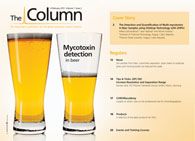Columnless separation with water and CO2
A discovery during the investigation of subcritical water chromatography has led to a novel method that could provide a green and cheap addition to the analytical chemist?s toolbox.
A discovery during the investigation of subcritical water chromatography has led to a novel method that could provide a green and cheap addition to the analytical chemist’s toolbox. The research, published in Analytical Chemistry,1 describes a method in which mixtures of carbon dioxide and water are used as both mobile and stationary phases, capable of performing separations on the inside of an uncoated capillary.
The researchers were experimenting with using subcritical water saturated with carbon dioxide as a mobile phase. They used a conventional packed column as a stationary phase and stainless steel tubing either side of the column. When they removed the column and flushed the system through they were surprised to find that separation was still occurring. They discovered that the water was forming a thin coating on the inside of the tubing and acting as a stationary phase. The researchers used this to determine a method using water saturated with CO2 as a stationary phase and CO2 saturated with water as a mobile phase. Analytes are separated based on how well they dissolve in water and CO2 — the more water-soluble elute later than those that are more soluble in CO2. This method uses only cheap and non-toxic chemicals, making it environmentally friendly and according to the researchers offers very good sample capacity, peak symmetry and retention time reproducibility.
1. M.O. Fogwill and K.B. Thurbide, Anal. Chem., 82(24), 10060–10067 (2010).
This story originally appeared in The Column. Click here to view that issue.
Determining Enhanced Sensitivity to Odors due to Anxiety-Associated Chemosignals with GC
May 8th 2025Based on their hypothesis that smelling anxiety chemosignals can, like visual anxiety induction, lead to an increase in odor sensitivity, a joint study between the University of Erlangen-Nuremberg (Erlangen, Germany) and the Fraunhofer Institute for Process Engineering and Packaging (Freising, Germany) combined behavioral experiments, odor profile analysis by a trained panel, and instrumental analysis of odorants (gas chromatography-olfactometry) and volatiles (gas chromatography-mass spectrometry).
Investigating 3D-Printable Stationary Phases in Liquid Chromatography
May 7th 20253D printing technology has potential in chromatography, but a major challenge is developing materials with both high porosity and robust mechanical properties. Recently, scientists compared the separation performances of eight different 3D printable stationary phases.
Detecting Hyper-Fast Chromatographic Peaks Using Ion Mobility Spectrometry
May 6th 2025Ion mobility spectrometers can detect trace compounds quickly, though they can face various issues with detecting certain peaks. University of Hannover scientists created a new system for resolving hyper-fast gas chromatography (GC) peaks.

.png&w=3840&q=75)

.png&w=3840&q=75)



.png&w=3840&q=75)



.png&w=3840&q=75)









